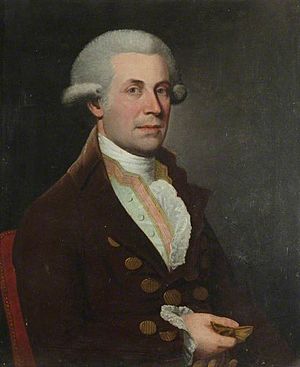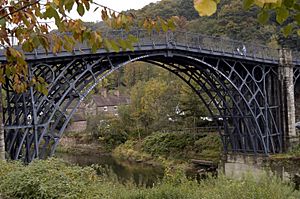Thomas Farnolls Pritchard facts for kids
Quick facts for kids
Thomas Farnolls Pritchard
|
|
|---|---|
 |
|
| Born |
Thomas Farnolls Pritchard
May 1723 Shrewsbury, Shropshire, England
|
| Died | 23 December 1777 (aged 54) |
| Known for | designing the Iron Bridge |
| Spouse(s) | Elinor Russell |
Thomas Farnolls Pritchard (born in May 1723 – died December 23, 1777) was a talented English architect and interior designer. He is most famous for creating the plans for the world's very first bridge made of cast iron.
Contents
Who Was Thomas Pritchard?
Early Life and Training
Thomas Pritchard was born in Shrewsbury, Shropshire, England. He was baptised on May 11, 1723. His father was a joiner, which is someone who builds things with wood. Thomas also trained as a joiner, learning how to work with wood.
But Thomas didn't stop there. He became a professional architect, designing buildings. He also became an interior designer, making the inside of homes and other places look beautiful. He was especially good at designing fancy fireplaces and decorations for rooms. He also designed monuments for graves.
Working with Others
Pritchard often worked with other skilled people. For example, he worked with William Baker of Audlem, who was also an architect. Baker used Pritchard's plans to build St John's Church, Wolverhampton.
Another person, Joseph Bromfield, started as a plasterer working for Pritchard. But Bromfield learned a lot from Pritchard. He became a very good architect himself and took over much of Pritchard's work after Thomas passed away.
Pritchard's Building Designs
Some of Pritchard's buildings were described as "pleasant provincial work." This means they were nice, well-built structures, but not hugely famous. Examples include the rebuilding of St Julian's Church in Shrewsbury and Hatton Grange in Shropshire.
Designing Interiors and Monuments
Pritchard was excellent at making the inside of buildings look special. He designed parts of Croft Castle and Gaines in Whitbourne. He also worked on Shipton Hall and the ballroom at Powis Castle. He designed beautiful fireplaces for places like Broseley Hall. He even created the fancy rococo drawing room at Tatton Hall, which is in Cheshire.
He also designed many monuments for people's graves. These monuments often used colorful marbles. They were usually in the rococo or Gothic styles. Later, he started using the neoclassical style, which was popular at the time. You can find his monuments in churches across Shropshire. Some are in places like Acton Round, Ludford, and Barrow.
Other Important Projects
Pritchard designed the Shrewsbury foundling hospital. This was a place built in 1760 to care for children who didn't have families. It was like a branch of the famous Foundling Hospital in London. Later, this building became a workhouse. Today, it is part of Shrewsbury School.
He also worked in Ludlow. He helped rebuild the town's jail and the Hosier's Almshouses, which were homes for poor people. He also made changes to the Guildhall, a public building.
The Famous Iron Bridge
In 1769, Pritchard moved from Shrewsbury to Eyton on Severn. There, he started farming, but he kept working as an architect. He had many ideas for bridges, but none of them were built until he planned a bridge made of cast iron. This bridge was meant to cross the River Severn in Coalbrookdale, Shropshire. He used ideas from how wooden bridges were built and adapted them for iron.
A slightly changed version of his design was built at the ironworks in Coalbrookdale. The work on the bridge started in 1777 and finished in 1779.
Pritchard's Death
Sadly, Thomas Pritchard died on December 23, 1777, at the age of 54. This was before his famous The Iron Bridge was completely finished. However, his amazing design led to the creation of the world's first arch bridge made entirely of cast iron.
He was buried in St Julian's Church in Shrewsbury. His grave also remembers his wife, Elinor Russell, and their three children who died when they were young.


